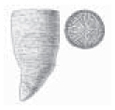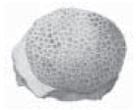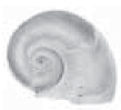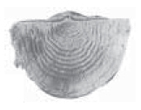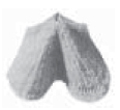
|
||||
|
|
||||
|
|
|
Birdsong Shale Fossils 10.10.2006 -- The Birdsong Shale of Vulcan Quarry, Parsons, Tennessee consists of alternating layers of bluish-green clay shale and calcareous [limy] shale beds. The majority of these shale beds are two to three inches thick, although some may be as thick as eight inches. Birdsong Shale, as a whole, is 25-40 feet thick but can reach a thickness of 60 feet.1
Birdsong Shale is very fossiliferous in Vulcan Quarry. You
should be able to find a number of fine specimens from this
location, including corals, brachiopods, gastropods,
nautiloids, bryozoans, and an abundance of crinoids [mostly
stems]. On a recent field trip to Vulcan Quarry, a
softball-sized crinoid calyx [head] was found. Although a
large number of trilobites are believed to have inhabited the
Ross Shelf [location of Birdsong Shale] during the Devonian
Age, few intact trilobite fossils can be found there.
Trilobite specimens tend to be very fragile and
fragmentary,
Phacops The Phacops [pictured above] was widespread throughout North America during the Devonian Age and is often beautifully preserved.2 With close examination and determination, you may find a trilobite or two in Vulcan Quarry. The three zones of the Birdsong Shale were named from the dominant fossil types seen within them. The zones are: [1] Trilobite Zone–approximately 22 feet thick; [2] Bryozoan Zone–6 feet thick; and [3] Brachiopod Zone–33 feet thick.1
For fossils found in Vulcan Quarry, your specimen card should
contain the following information: What I would like to do now is give you a look at some of the specimens to be found in the Birdsong Shale.
ANTHOZOA Conical-shaped coralla [coral] which had a funnel-shaped gullet leading from the mouth to a large central cavity which worked like a stomach. It had tentacles like a hydra.3
Tubulate corals [honeycomb corals] range from small sheets to massive domes. The walls are thin, perforated by small pores. They lived in shallow water.4
Most trilobite fossils have lost the appendages. These
structures do not preserve well. The name trilobite means
"three-lobed ones." I might be interpreted as
threeparts consisting of head, body, and tail. But, in fact,
the name actually refers to parts that run lengthwise and are
separated by furrows, not joints. These grooves divide
every
GASTROPOD
BRYOZOA
BRACHIOPOD
BRACHIOPOD
NAUTILOID
CRINOID
Works Cited: 2. Ida Thompson; National Audubon Society Field Guide to North American Fossils; Alfred A Knopf, Inc.; New York; 1996 3. Patricia V. Rich, Thomas H. Rich, Mildred A. Fenton, and Carroll L. Fenton; The Fossil Book: A Record of Prehistoric Life; Dover Publishing, Inc.; Mineola, New York; 1996 4. Cyril Walker and David Ward; Fossils: Eyewitness Handbook; Dorling Kindersley, Inc., New York; 1992 Images on this page courtesy of Index Fossils of North America by Hervey W. Shimer and Robert R. Shrock [1959]; The Fossil Book: A Record of Prehistoric Life; Fossils: Eyewitness Handbook
|
||
|
|
||||

